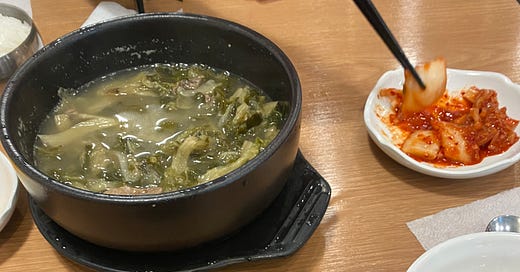We were on our way to Masan, the south-eastern coastal city that my mum grew up in. It was going to be a difficult weekend; we were starting our trip with a visit to the cemetery that my mum’s best friend is buried in. She died in 2021 and my mum didn’t get a chance to say goodbye, thanks to COVID and lockdowns and an inability to travel to her home. Seong-Ok was a devout Catholic and the name emblazoned on the headstone was not her Korean one, but instead: Christina. Her brother, a 70-year-old bishop with a booming voice and a wide smile, greeted us at a mountain-side restaurant where we ate countless plates of banchan. When we arrived at the cemetery they lay flowers down and as they were leaving each other, my mum and Seong-Oks brother embraced and let out a guttural yelp of grief. It ran right through me.
We had begun our journey at Seoul Express Bus Station at 8am, where we sat down for a hearty Korean breakfast: bibimbap for me and dried cabbage soup flavoured with beef for my mum. Bibimbap is such a brilliantly basic dish that I eat for breakfast, lunch or dinner. It’s essentially just vegetables with rice and egg, and although you might know it as a hot-stone dish, it can be made just as a regular bowl of hot rice. The trick is to treat each vegetable separately, so the flavours become distinct.
Keep reading with a 7-day free trial
Subscribe to Since No One Asked to keep reading this post and get 7 days of free access to the full post archives.





